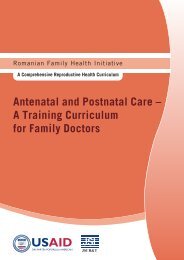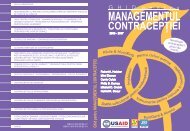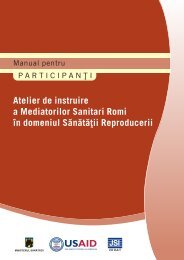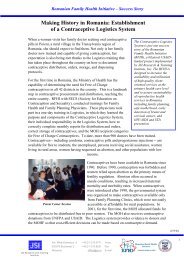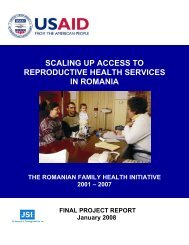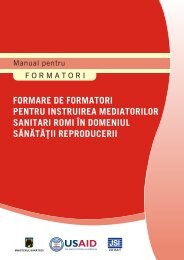Training of Roma Health Mediators in Reproductive Health
Training of Roma Health Mediators in Reproductive Health
Training of Roma Health Mediators in Reproductive Health
Create successful ePaper yourself
Turn your PDF publications into a flip-book with our unique Google optimized e-Paper software.
cells (which fight aga<strong>in</strong>st <strong>in</strong>fections) and destroy<strong>in</strong>g them. The HIV <strong>in</strong>fected person<br />
may look normal for 2-10 years while the immune system is break<strong>in</strong>g down slowly.<br />
• Once the immune system is destroyed the person is likely to get a variety <strong>of</strong> diseases,<br />
as her/his body cannot fight aga<strong>in</strong>st any <strong>in</strong>fections. This condition is called AIDS.<br />
With AIDS, symptoms <strong>of</strong> many diseases appear and that is why it is called a<br />
syndrome (group <strong>of</strong> symptoms). AIDS has no treatment and is always fatal, but it can<br />
be prevented.<br />
Expla<strong>in</strong> the difference between HIV, HIV <strong>in</strong>fection and AIDS.<br />
• HIV is the virus that causes the disease by destroy<strong>in</strong>g the ability <strong>of</strong> the human body<br />
to fight aga<strong>in</strong>st any <strong>in</strong>fections.<br />
• HIV <strong>in</strong>fection is the condition when the virus is present <strong>in</strong> the body. The HIV<br />
<strong>in</strong>fected person has no symptoms and s/he may look healthy for 2-10 years but s/he<br />
can spread HIV to other people.<br />
• AIDS is the late stage <strong>of</strong> the HIV <strong>in</strong>fection when symptoms appear. It leads to death.<br />
HIV is present <strong>in</strong> the blood and other body fluids <strong>of</strong> the <strong>in</strong>fected person.<br />
Prepare a list <strong>of</strong> myths and misconceptions about HIV/AIDS that are common <strong>in</strong> the<br />
community. The tra<strong>in</strong>er document Myths and Truths about HIV/AIDS may be used for<br />
this; however, it is best to use myths that are common <strong>in</strong> the <strong>Roma</strong> communities.<br />
Make enough slips <strong>of</strong> paper so that each participant has at least one statement.<br />
Make a sign that says “Myth” and a sign that says “Truth”. Post the signs on opposite<br />
ends <strong>of</strong> the room. You will also need many little pieces <strong>of</strong> mask<strong>in</strong>g tape for this activity.<br />
Expla<strong>in</strong> to participants that they will be <strong>in</strong>volved <strong>in</strong> an activity which is <strong>in</strong>tended to dispel<br />
myths, and provide accurate <strong>in</strong>formation about HIV/AIDS.<br />
• Pass out a slip <strong>of</strong> paper to each participant. Tell participants the statement on the<br />
paper is either true or false. If the statement is true, ask participants to tape the<br />
statement to the wall under the sign that says “Truth”. If their statement is false, ask<br />
them to tape the statement to the wall under the sign that says “Myth”.<br />
• Once all the statements are taped to the wall, review each <strong>of</strong> the statements with the<br />
entire group. Together, confirm whether each statement is a truth or a myth. (If there<br />
are any errors, move the statement and tape it under the correct sign.) Provide<br />
additional <strong>in</strong>formation and answer questions, us<strong>in</strong>g the tra<strong>in</strong>er document HIV/AIDS:<br />
What is True? What is False? (Sample Discussion Po<strong>in</strong>ts) as a basis.<br />
Distribute the participant document “How Is HIV/AIDS Spread?” and discuss it, if<br />
appropriate.<br />
Ask participants:<br />
‣ What messages would you pass on <strong>in</strong> the community regard<strong>in</strong>g protection aga<strong>in</strong>st<br />
HIV/AIDS?<br />
169<br />
RFHI/JSI <strong>Roma</strong>nia <strong>Tra<strong>in</strong><strong>in</strong>g</strong> <strong>of</strong> RHMs <strong>in</strong> <strong>Reproductive</strong> <strong>Health</strong> Session 10: STIs



